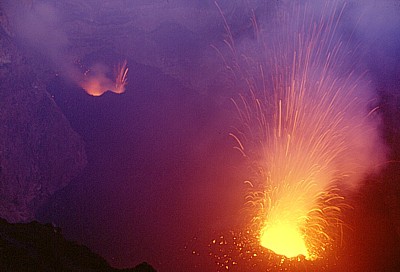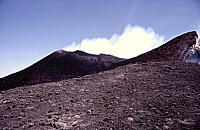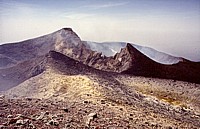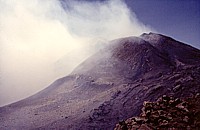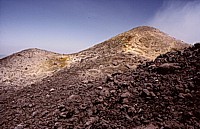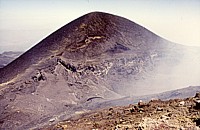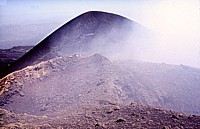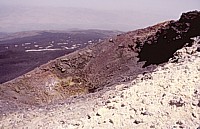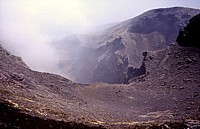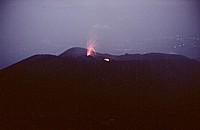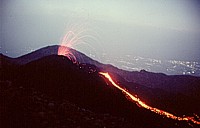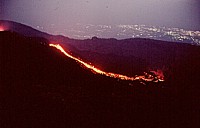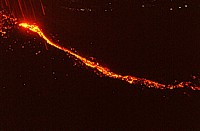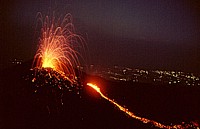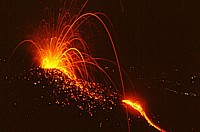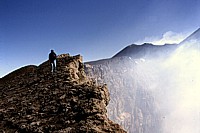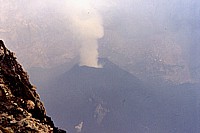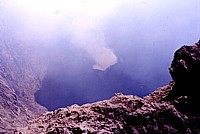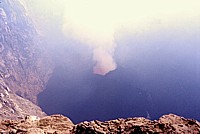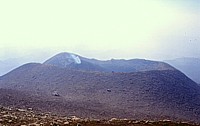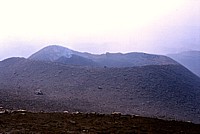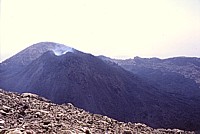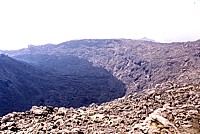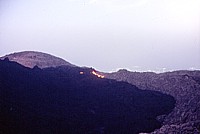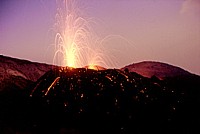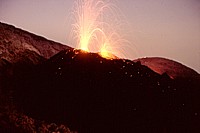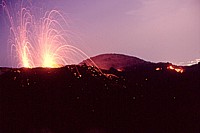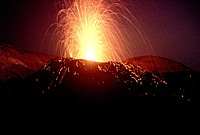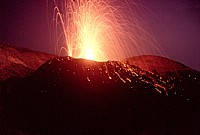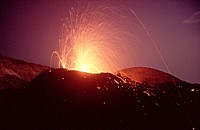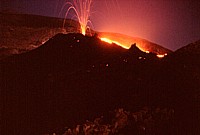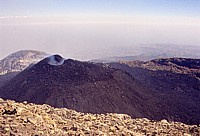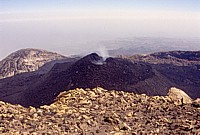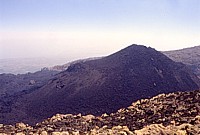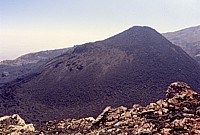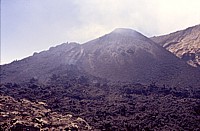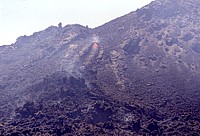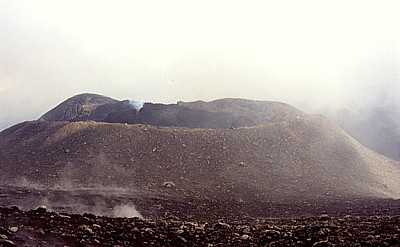 |
These
are my photographs of Etna's eruptive activity in 1997. I started
visiting the summit craters (where activity was concentrated at
the time) in mid-June 1997 and by the end of the year had made 13
visits. During nearly all of them there was quite spectacular activity
to see and thus they were very strong experiences. Yet the photographic
record of these visits is not entirely complete: in September and
October 1997, my camera frequently refused to work correctly, and
so I lost some of the most beautiful photographs (such as on 28
September and 9 October). This became a recurring nightmare throughout
the following years, when I dreamt of watching Etna erupt without
having a camera or a roll of film with me... Over the years, though,
I saw and photographed so many beautiful moments at the volcano
that the nightmare eventually disappeared. Some of my 1997 photographs
of Etna feature among the most marvellous I ever managed to take
on the volcano. |
First
summit visit, 14 June 1997
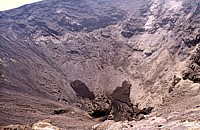 |
Left:
the impressive funnel-shaped pit of the Voragine on 14 June
1997. The degassing vent on the crater bottom is seen to
be blocked by landslides from the crater walls
Right: eruptive activity at the northwestern vent cluster
of the Bocca Nuova, with effusion of two lava flows on the
crater bottom, 14 June 1997 |
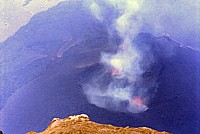 |
Second
summit visit, 11 July 1997
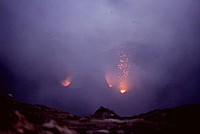 |
Two
photographs of eruptive activity at the northwestern vent
cluster in the Bocca Nuova on the evening of 11 July 1997.
Small Strombolian explosions are occurring at three vents,
and a fourth vent (visible in right center in right photograph)
is emitting lava |
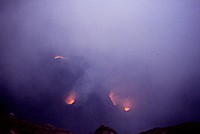 |
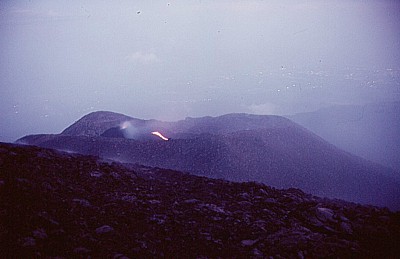
|
| This
is how the Southeast Crater looked like on the evening of
11 July 1997 when seen from the southeastern rim of the
former Central Crater (which is now largely replaced by
the Bocca Nuova and the Voragine). At that time the Southeast
Crater was a broad, low cone with a 150 m-diameter depression
at its summit. Eruptive activity started in early November
1996, after five years of quiet, from a small vent on the
crater botton. During the following months a very small
cone was built around the vent, which also emitted lava
at an extremely low rate; this lava began to fill the lower
parts of the crater. By mid-July 1997, the active intracrater
cone had grown a few tens of meters high, and lava issued
from vents on its flanks or near its base; the level of
the lava fill was still about 5-10 m below the lowest point
of the crater rim (seen behind the active glowing lava flow
in this photograph) but rose constantly and overflowed on
19 July, 8 days after this image was taken |
Third
summit visit, 16 July 1997
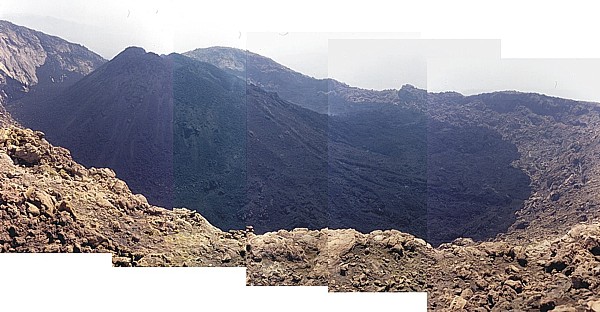
|
| Photomosaic
of the Southeast Crater showing intracrater cone and surrounding
lava field, 16 July 1997. Images were taken from the southwestern
rim of the crater. Note lava flow channels in center, where
an active lava flow was observed on the evening of 11 July
1997 (see photos above) |
Fourth
summit visit, 19 July 1997
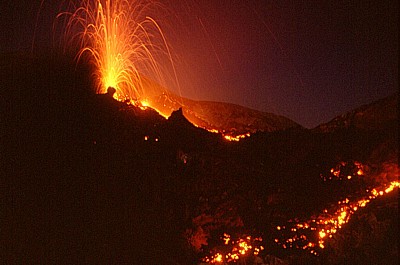
|
| The
first overflow of lava from the Southeast Crater occurs
late on the evening of 19 July 1997, as repeated surges
of lava from the active intracrater cone (seen in Strombolian
activity in the background) pile up against low point on
the crater rim. This awesome display takes place in a suggestive
landscape shaped by the lava flows that have been emplaced
during the previous days |
Fifth
summit visit, 25 July 1997
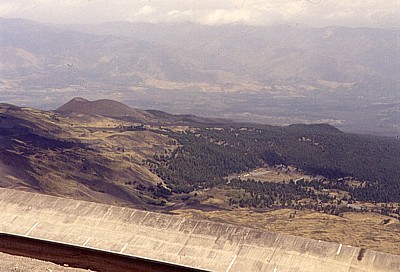
|
| First
view of a place that I fell in love with two years later,
and which was devastated by an eruption five years later:
Piano Provenzana. This photograph was taken on 25 July 1997,
when visiting the observatory at the Pizzi Deneri (about
2700 m elevation on Etna's northeastern flank). Piano Provenzana
is the flat spot amidst the forest that occupies much of
the center right of the photograph. The large pyroclastic
cone at center left is Monte Nero, formed during a flank
eruption in 1646-1647. Concrete structure in the foreground
hosts a water-tube tiltmeter |
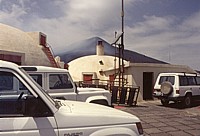 |
The
Etna Observatory (rebuilt in 1979 after the old observatory
was destroyed by the 1971 eruption) lies on the Pizzi Deneri,
on the northern rim of the Valle del Leone, and hosts monitoring
equipment as well as rooms where scientists can stay during
measuring campaigns. The Northeast Crater (right) forms
a scenic background |
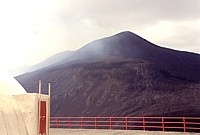 |
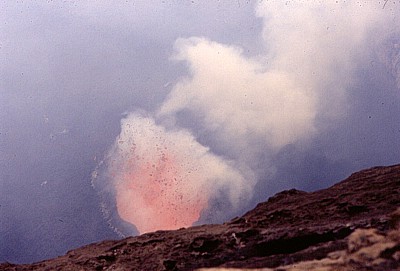 |
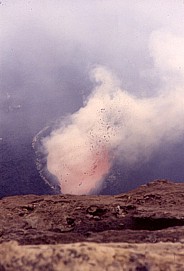 |
| Large
vent in the northwestern part of the Bocca Nuova in vigorous
activity on 25 July 1997. The vent, about 40 m wide, is
filled with boiling lava that frequently shoots up in short-lived
fountains, at times rising higher than the crater rim from
which these photographs were taken |
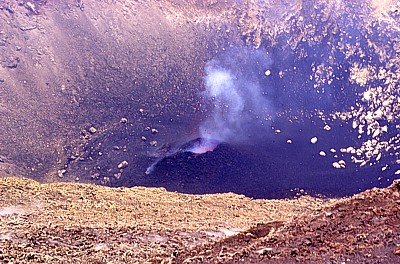
|
| The
Voragine awakens! After about six years without eruptive
activity, mild Strombolian activity starts within this crater
sometime around 20 July 1997 and is first observed directly
five days later, when this photograph was taken. A very
small cone, about 10 m tall, has begun to grow on the crater
floor, in exactly the same location of the former degassing
pit, which in mid-June was seen to be obstructed. Frequent
Strombolian bursts eject incandescent scoriae and bombs
only to a few tens of meters above the vent. Difficult to
imagine that one year later, and again in 1999, the same
crater will produce some of the most powerful explosive
eruptive events ever seen on Etna |
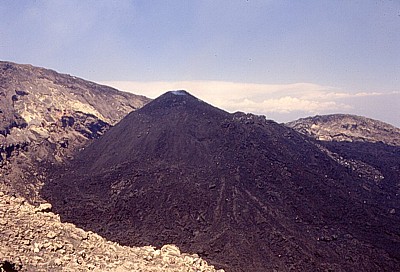
|
| The
Southeast Crater and its dark intracrater cone on 25 July
1997, seen from south-southwestern crater rim. From this
point the intracrater cone appears quite symmetrical, although
a rugged area on the right (eastern) flank of the cone marks
an area where lava has issued. The summit vent, site of
mild Strombolian activity, is only a few meters in diameter |
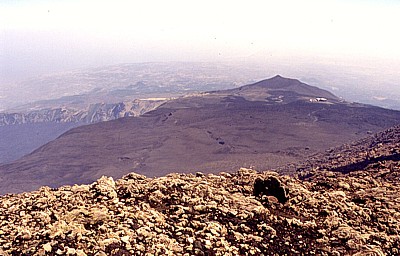
|
| Panoramic
view from the southeastern rim of the Southeast Crater toward
the Piano del Lago, the Montagnola (peak in the background),
and the Valle del Bove (left). The flat area at the base
of the Southeast Crater still shows the eruptive fissures
of December 1991, where the large flank eruption of 1991-1993
started. The building seen in front of the Montagnola at
right is the Torre del Filosofo mountain hut. Photograph
taken on 25 July 1997 |
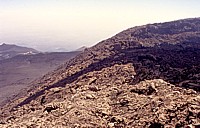 |
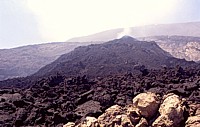
|
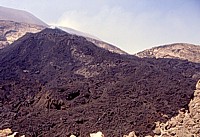 |
Continuation
of the clockwise tour around the Southeast Crater, 25 July
1997. Left photograph shows small lava overflow of 19 July
(see photos above) over low southeastern point of the crater
rim, which has lasted only a few hours but will be repeated
during the following days. Middle photograph shows the peculiar
shape of the intracrater cone, which resembles a lava dome
crowned by a small spatter cone. This is the "collar"
that has been visible in some of the previous photographs
of 25 July. Right image is a panorama of the Southeast Crater
from south-southeast, with the lava field filling the crater
and the active intracrater cone at left. The huge fuming
cone of which part can be seen in the left background is
the Northeast Crater |
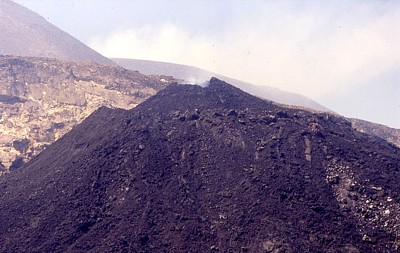
|
| Upper
portion of the intracrater cone of the Southeast Crater,
showing once more the "collar"-shaped structure
surrounding the pyroclastic conelet at the summit. Note
that many small lava lobes have issued from the crest of
the "collar" |
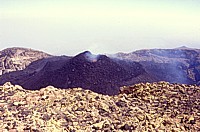 |
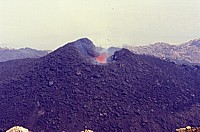
|
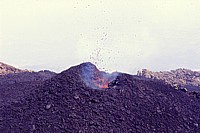 |
Eruptive
activity at the summit of the intracrater cone of the Southeast
Crater, 25 July 1997. Left photograph is a wide-angle view
from the western rim of the crater, while the other two
images are zooms on the active explosive vent displaying
small Strombolian bursts. At that time the intracrater cone
was still small enough to permit observers to look right
down into its vent; about two months later the cone had
grown as high as the observation point on the high western
rim of the Southeast Crater |
Sixth
summit visit, 29 July 1997
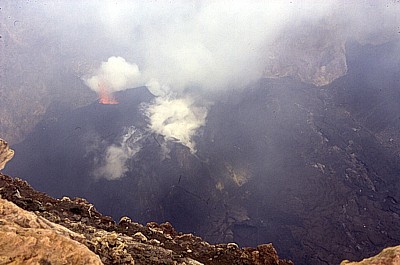
|
| Chaotic,
steaming terrain surrounding a single eruptive vent in the
northwestern part of the Bocca Nuova, 29 July 1997. Even though
I visited Etna about twice a week in the summer of that year,
the morphology of this vent area changed surprisingly rapidly
|
|
| The
Southeast Crater seen from the southeastern rim of the former
Central Crater on 29 July 1997 (compare to photographs taken
from the same spot on 11 and 16 July 1997). Note that both
the summit of the intracrater cone and the level of the
lava fill within the crater have risen notably |
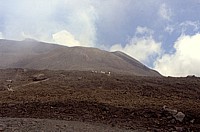 |
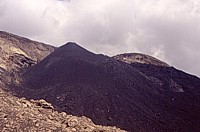
|
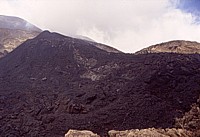 |
Left:
the Southeast Crater seen from Torre del Filosofo, 29 July
1997. Dark streak on extreme right flank of the cone is
a lobe of lava that has overflowed the crater rim after
the 25 July visit and extended much further downslope than
the first overflow on 19 July. Center: viewed from south-southwest,
the intracrater cone appears as regular as during the previous
visit, four days earlier. Right: little change is evident
also once the same cone is viewed from south-southeast |
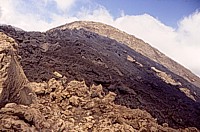 |
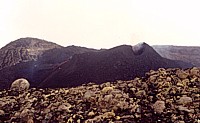
|
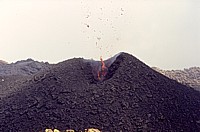 |
Left:
lava spillover on low southeastern rim of the Southeast
Crater, 29 July 1997, rendering a full round tour of the
crater impossible. Center: wide-angle view of the intracrater
cone from western rim of the Southeast Crater. Note lava
effusion on left (northern) side of the intracrater cone.
Right: zoom on the lava-spitting mouth of the intracrater
cone, 29 July. On this day the activity was much stronger
than during the previous visit four days earlier |
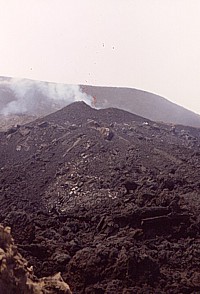 |
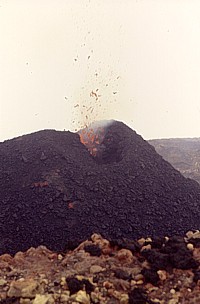 |
| Mild
explosive activity at the Southeast Crater's intracrater
cone on 29 July 1997, seen from southeast (left) and west
(right) |
|
|
![]()

